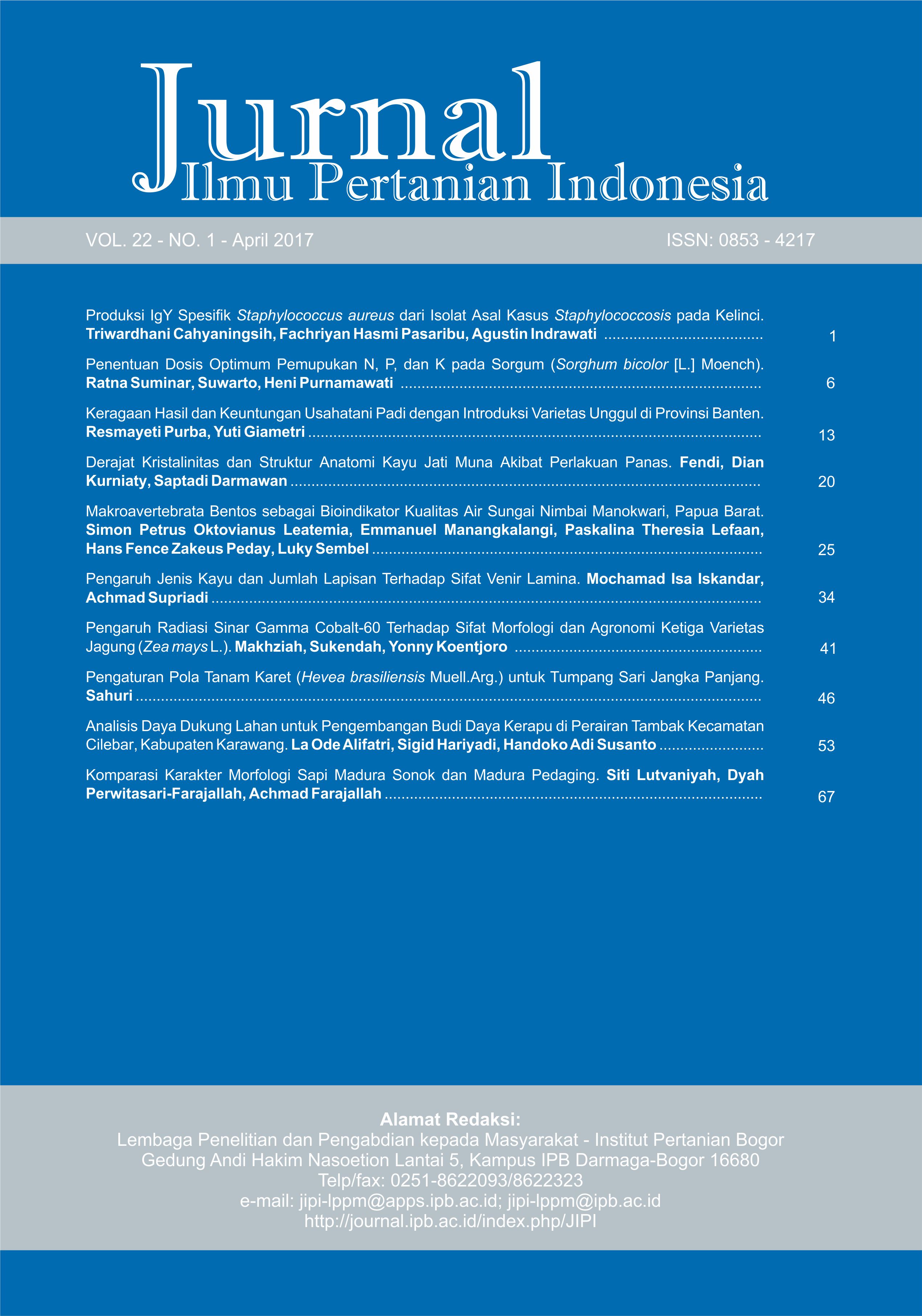Pengaruh Jenis Kayu dan Jumlah Lapisan Terhadap Sifat Venir Lamina
Abstract
This study aims to determine the effect of wood species and the number of layers of veneer against laminated veneer properties. Wood species consist of sengon, pine, and mixed pine sengon. Laminated veener made by a number of layers consist of 4, 6, and 8 layers. The difference of a number of layers was to identify quality of laminated veneer. The adhesive used is urea formaldehyde (UF) liquid. The results showed that the average moisture content of 10.76%, density of 0.54 g/cm3, delamination 5.8%, MOE 124.108 kg/cm2, and MOR 450.74 kg/cm2. The moisture content and delamination made all meet the Indonesian National Standard. Statistically, wood species were a significant effect on moisture content, density, MOE, and MOR, while various of layers were a significant effect on moisture content, density, delamination, MOE, and MOR. The number of layer’s laminated veneer made higher of water content, density, delamination, and MOR.Downloads
References
[BSN] Badan Standardisasi Nasional. 2000. SNI 01-6240-2000. Venir Lamina. Badan Standardisasi Nasional.
Balfas J. 2010. Jenis kayu alternative untuk pertukangan. In Prosiding Seminar Nasional Inovasi Teknologi Pengolahan Jati Cepat Tumbuh dan Kayu Pertukangan Lainnya. (pp. 98-107).
Basuki A, As’ad S, Putri RN, Hermawan. 2015. Kapasitas lentur balok (LVL) kayu sengon pada variasi penampang. Prosiding MAPEKI ke XVII. 11 Nopember 2015. Medan, Sumatera Utara. pp: 131-137.
Burdurlu E, Killic M, Ilce AC, Uzunkavak O. 2007. The effect of ply organization and loading direction on bending strength and modulus of elasticity in laminated veneer lumber (LVL) obtained from beech (Fagus orientalis L.) and lombardy poplar (Populus nigra L.). Construction and Building Materials. 21(8): 1720-1725. http://doi.org/dnx4ns
Colak S, Colakoglu G, Aydin I. 2005. Effects of logs steaming, veneer drying and aging on the mechanical properties of laminated veneer limber (LVL). Building and Environment. 42(1): 93-98. http://doi.org/fj3mj7
Ekawati D. 1998. Pengaruh jenis perekat dan pengaturan letak kayu meranti merah serta kelapa terhadap sifat fisik mekanik balok lamina. Contoh kecil bebas cacat. [Skripsi]. Bogor (ID): Institut Pertanian Bogor.
Hendradi TC. 2012. Statistik Six Sigma dengan Minitab. Panduan Cerdas Inisiatif Kualitas. Yogyakarta (ID): ANDI OFFSET.
Iskandar MI. 2007. Pembuatan LVL mahoni dengan perekat phenol formaldehida. Prosiding MAPEKI ke X. 9 – 11 Agustus 2007. Pontianak, Kalimantan Barat. pp: 986-993.
Iskandar MI. 2014. Pengaruh jumlah lapisan dan macam sambungan terhadap sifat-sifat venir lamina. Prosiding MAPEKI ke XVI. 6 November 2014. Balikpapan, KalimantanTimur. pp: 372-380.
Kelly MW. 1977. Critical literature review of relationship between processing parameters and physical properties of particleboars. General Technical Report FLL-10.
Nursiam T. 2003. Pengaruh jumlah lapisan terhadap sifat fisis mekanis papan venir lamina dari kayu karet (Hevea brasiliensis). [Skripsi]. Bogor (ID): Institut Pertanian Bogor.
Purwanti R, Hastuti N, Massijaya MY. 2011. Pengaruh komposisi venir terhadap karakteristik LVL dari kayu mahoni (Swietenia mahagoni (L) Jack) dan baros (Manglietia glauca). Prosiding MAPEKI ke XIV. Yogyakarta. 2 November 2011. pp: 233-239.
Sudjana. 2004. Desain dan Analisis Eksperimen. Bandung (ID): Tarsito.
Sudrajat R. 1980. Studi tentang pengujian kayu kapur dan meranti untuk venir lamina. [Skripsi]. Bogor (ID): Institut Pertanian Bogor.
Sulastiningsih IM, Memed R, Sutigno P. 1993. Pengaruh jenis campuran kayu terhadap sifat venir lamina. Jurnal Penelitian Hasil Hutan. 11(8): 308-312.
Sulastiningsih IM, Nurwati, Santoso A. 2005. Pengaruh lapisan kayu terhadap sifat bamboo lamina. Jurnal Penelitian Hasil Hutan. 23(1): 15-22.
This journal is published under the terms of the Creative Commons Attribution-NonCommercial 4.0 International License. Authors who publish with this journal agree to the following terms: Authors retain copyright and grant the journal right of first publication with the work simultaneously licensed under a Creative Commons Attribution-NonCommercial 4.0 International License. Attribution — You must give appropriate credit, provide a link to the license, and indicate if changes were made. You may do so in any reasonable manner, but not in any way that suggests the licensor endorses you or your use. NonCommercial — You may not use the material for commercial purposes.























